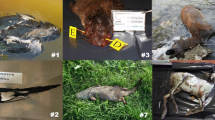Abstract
The plankton test (generally, diatom test) is one of the methods available to diagnose the cause of death of submerged bodies. The solubilization method using tissue solubilizer Soluene-350 was used in this study to detect not only diatoms but also green algae, based on the fact that the solubilizer does not digest the cell walls of green algae which are made from cellulose. Detection of green algae from organs of submerged cadavers is very informative to determine drowning in fresh water, and also in cases where only few diatoms are detected in the organs.[/p]
Similar content being viewed by others
References
Neidhart DA, Greendyke RM (1967) The significance of diatom demonstration in the diagnosis of death by drowning. Am J Clin Pathol 48: 377–382
Udermann H, Schuhmann G (1975) Eine verbesserte Methode zum Diatomeen-Nachweis. Z Rechtsmed 76:119–122
Peabody AJ (1977) Diatoms in forensic science. J Forensic Sci Soc 17:81–87
Peabody AJ (1980) Diatoms and drowning: a review. Med Sci Law 20: 254–261
Ranner G, Juan H, Udermann M (1982) Zum Beweiswert von Diatomeen in Knochenmark beim Ertrinkungstod. Z Rechtsmed 88:57–65
Auer A, Mottonen M (1988) Diatoms and drowning. Z Rechtsmed 101:87–98
Auer A (1991) Qualitative diatom analysis as a tool to diagnose drowning. Am J Forensic Med Pathol 12: 213–218
Ludes B, Quantin S, Coste M, Mangin P (1994) Application of a simple enzymatic digestion method for diatom detection in the diagnosis of drowning in putrified copses of diatom analysis. Int J Legal Med 107: 37–41
Spitz WU, Schneider V (1964) The significance of diatoms in the diagnosis of death by drowning. J Forensic Sci 9:11–18
Jääskeläinen AJ (1967) Diatomeenbefunde in Wasserleichen. Eine neue Methode zur quantitativen Messung der Diatomeen im Organismus. Dtsche Z Gerichtl Med 61:41–47
Plueckhahn VD (1977) Alcohol and accidental submersion from watercraft and surrounds. Med Sci Law 17(2): 246–250
Schellmann B, Sperl W (1979) Nachweis in Knochenmark (Femur) Nichtertrunkener. Z Rechtsmed 83:319–324
Gylseth B, Mowe G (1979) Diatoms and lung tissue. Lancet 29: 1375
Foged N (1983) Diatoms and drowning — Once more. Forensic Sci Int 21:153–159
Polson CJ, Gee DJ, Knight B (eds) (1985) Drowning. In: The essentials of forensic medicine. Pergamon Press, Oxford, pp 421–428
Pachar JV, Cameron JM (1992) Submersion cases: a retrospective study 1988–1990. Med Sci Law 32:15–17
Tomita M, Fujita T, Mikami M (1981) An application of the oxygen plasma incineration to the identification of death by drowning (in Japanese). Nat Res Inst Police Sci 34:27–30
Fukui Y, Hata M, Takahashi S, Matsubara K (1980) A new method for detecting diatoms in human organs. Forensic Sci Int 16:67–74
Matsumoto H, Fukui Y (1993) A simple method for diatom detection in drowning. Forensic Sci Int 60:91–95
Funayama M, Aoki Y, Sebetan IM, Sagisaka K (1987) Detection of diatoms in blood by a combination of membrane filtering and chemical digestion. Forensic Sci Int 34:175–182
Terazawa K, Takatori T (1980) Isolation of intact plankton from drowning lung tissue by centrifugation in a colloidal silica gradient. Forensic Sci Int 16:63–66
Kobayashi M, Yamada Y, Zhang WD, Itakura Y, Nagao M, Takatori T (1993) Novel detection of plankton from lung tissue by enzymatic digestion method. Forensic Sci Int 60: 81–90
Okada T, Ide K, Isahai I, Okada M (1983) Studies on detection method of planktons contained chlorophyll by fluorescence. Jpn J Leg Med 37:194–197
Qu J, Wang E (1992) A study on the diagnosis of drowning by examination of lung chlorophyll(a) of planktons with a spectrofluorophotometer. Forensic Sci Int 53: 149–155
Smith IK, Lang AL (1987) Decoloration and solubilization of plant tissue prior to determination of3H,14C, and35S by liquid scintillation. Anal Biochem 164:531–536
Mizuno T (1978) Illustrations of the freshwater plankton of Japan, Revised edn. Hoikusha, Osaka (in Japanese)
Author information
Authors and Affiliations
Rights and permissions
About this article
Cite this article
Yoshimura, S., Yoshida, M., Okii, Y. et al. Detection of green algae (Chlorophyceae) for the diagnosis of drowning. Int J Leg Med 108, 39–42 (1995). https://doi.org/10.1007/BF01845616
Received:
Revised:
Issue Date:
DOI: https://doi.org/10.1007/BF01845616




